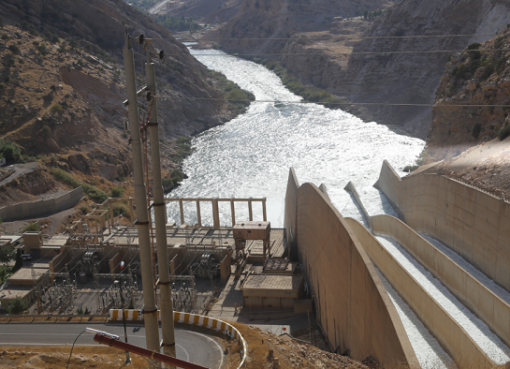Download
Climate change is one of the major challenges facing Iraq. Potentially, it could have a disastrous effect on the environment and economy, in particular on the agricultural sector. And while specific studies to assess the likely impact of climate change on Iraq have not yet been conducted, it is recognized that the country is particularly vulnerable due to its geographical and hydrological peculiarities. Iraq is located in an arid to semi-arid area where the dominant continental climate is typically cold in winter and hot in summer and characterized by limited rainfall, a high evaporation rate and water scarcity. Nevertheless, the upper reaches of the Euphrates and Tigris rivers, which are located at higher altitudes, receive significant amounts of precipitation in winter months (November-March) in the form of snow. In spring months (March-May) the melting snow generates runoff that flows downstream all the way to the Gulf through the Tigris and Euphrates and their tributaries. In other words, the flow in Iraqi rivers is generated mostly outside its borders in Turkey, Iran and Syria. However in spite of these geopolitical divisions, all the runoff from the snowmelt in the highlands of the Tigris and Euphrates river basins has flowed uninterruptedly to Iraq until recently. Iraq’s plentiful water resources in the past created vibrant river systems and an ecosystem of interconnected seasonal and permanent wetlands, the marshlands of southern Iraq. These marshlands, which are located in the immediate vicinity of the vast Arabian Desert, historically covered an area twice the size of Lebanon. They have provided the livelihood of local populations for thousands of years and forced the ancient inhabitants of Mesopotamia to develop water management skills to counteract the floods and droughts in the Tigris and Euphrates systems. Pessimistic Picture The predictions of the General Circulation Models (GCMs) used by the Intergovernmental Panel on Climate Change present a pessimistic picture of the flows in the Tigris and Euphrates rivers. Precipitation in the highlands of Turkey is predicted to be reduced by 10-60%, which in turn translates into a similar decline in the flow in the Tigris and Euphrates rivers. One recent study predicted that the Euphrates river flow will be reduced by 29% to 73% and the entire Fertile Crescent may disappear by the end of the century. The negative impact of climate change on Iraq is further magnified by human intervention in the natural cycle. A series of major dams and diversion schemes on the Euphrates and Tigris rivers and their tributaries have altered the hydrological cycle significantly in the last three decades. As the country furthest downstream in the basin, Iraq is heavily dependent on precipitation in the highlands of Turkey and Iran. Rainfall over Iraq is limited and the runoff generated from it is not significant. However, wet seasons provide essential soil moisture that prevents erosion, reduces irrigation requirements and contributes significantly to improving grazing and rangeland areas. Peak flows that occur naturally during spring times are now being absorbed by the huge storage areas behind the Turkish, Iranian and Syrian dams. Releases are controlled by neighboring countries according to their own needs and requirements. Iraq’s specific needs for agricultural production and various other economic and environmental purposes are not taken into account in the operation of the extensive network of hydraulic structures owned and operated by riparian countries. Crop production from irrigated land in Iraq is very sensitive to any change in the seasonal availability of water resources. The rain fed land in the northern part of the country is highly responsive to variations in the timing and quantity of rainfall. With increased control of and interference with the natural water cycle, agricultural production in the country is being further undermined. Marshland Not Fully Restored The most dramatic and deliberate alteration of the natural system has taken place in the delta in the southern part of the country, where during and after the Iraq-Iran war in the 1980s about 90% of Iraq’s marshes were drained. These unique wetlands, which have been a major contributor to food production and to the preservation of biodiversity in the area, were transformed into lifeless dry land as the result of a political decision. Unfortunately for Iraq, this decision coincided with the assumption by neighboring countries of almost complete control over water resources, forcing tens of thousands of inhabitants to flee the area. After the 2003 war and the downfall of the former regime a fundamental change took place in the attitude of the Iraqi government and resources have been made available to restore the marshlands. Nonetheless, despite the positive impact of these actions and programs, they are well below the level required to ensure the full restoration of the marshes. In addition, Iraq has been experiencing a number of serious problems that can be traced to climate change. This has been evident in the rapid expansion of the desertification process, increasingly frequent and intense dust storms, prolonged drought conditions, a reduction in rainfall across the country and unprecedented heat waves with temperatures rising above 50°C just last summer. (The recorded temperature in Iraq has risen significantly. The average temperature for the period 1988-2007 is higher than the average temperature for the earlier twenty years by 1°C in Baghdad and 1.5°C degrees in Nasiriya south of Baghdad). Similar trends can be seen in the recorded rainfall. For instance, rainfall in Baghdad during the past decade is less than the long-term average by about 50% (excluding the recent rainfall in Baghdad in late December 2012). FAO scientists believe that an increase of 1% in average temperature results in a 10% loss in agricultural productivity. It is therefore hardly surprising that the productivity of cultivated land in Iraq has declined until domestically produced food meets only 30% of the population’s needs. Factoring in Climate Change Despite the policies and programs that have been introduced in the Iraqi agriculture sector, much remains to be done at the level of policy and governance. Iraqi agricultural and food products are not competitive. They rely on subsidies and highly restrictive market regulations, including import controls. There is a pressing need to factor in the impact of climate change on Iraqi agriculture and other climate sensitive activities in the country. Obviously, Iraq’s capacity to adapt to climate change at the moment is marginal. However, it is never too late to develop the country’s capacity to adjust to this unavoidable eventuality both at the human and the economic levels. Iraq has the financial resources to invest in its future and to neutralize the negative impact of global warming on its economy. Moreover its youthful population is a significant human asset that can help guarantee a successful transition towards a better future and sustainable development.
*Iraq Ambassador to the Food and Agriculture Organization (FAO) of the United Nations.
Note by the Editor,
Source: MEES Vol. 56. No. 10, 08.March.2013, republished upon the kind approval of the author








Comment here